Betelgeuse, Alpha Orionis (α Ori), is a red supergiant star located in the constellation Orion, the Hunter. It has an estimated radius about 764 times that of the Sun and is one of the largest stars visible to the unaided eye. The supergiant lies at an approximate distance of 548 light-years from Earth. Marking Orion’s shoulder, it is one of the most recognizable stars in the night sky.
With an apparent magnitude that varies between 0.0 and 1.6, Betelgeuse is normally the second brightest star in Orion and the 10th brightest star in the sky. Most of the time, it is only slightly fainter than Achernar (Alpha Eridani) in the constellation Eridanus and slightly brighter than the Southern Pointer Hadar (Beta Centauri) in Centaurus. In infrared light, Betelgeuse is brighter than any other star in the sky.
In late 2019 and early 2020, Betelgeuse experienced an episode known as the Great Dimming, during which it faded to a historical minimum. The fading episode was explained by dust extinction and a decrease in effective temperature.
In 2024, a study proposed the existence of an invisible Sun-like companion as an explanation for the supergiant’s 6-year long secondary period. However, no companion has been directly detected.
Even though it is only 8 to 8.5 million years old, Betelgeuse is a massive star that has evolved quickly and is already approaching the end of its life cycle. It will go out as a supernova in the relatively near future. When it does, it will release its store of raw material needed to create a new generation of stars.
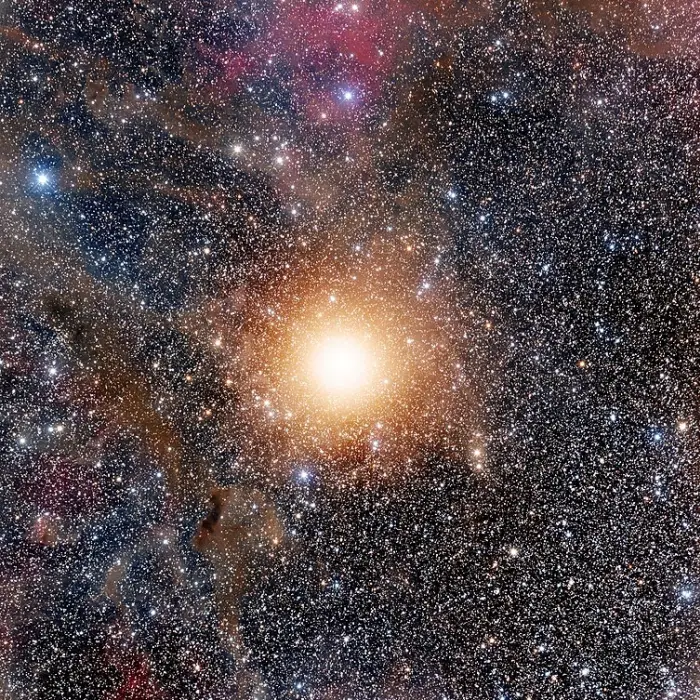
Betelgeuse is usually the tenth-brightest star in the night sky and, after Rigel, the second-brightest in the constellation of Orion. It is a distinctly reddish semiregular variable star whose apparent magnitude, varying between +0.0 and +1.6, has the widest range displayed by any first-magnitude star. Image credit: Adam Block/Steward Observatory/University of Arizona (CC BY-SA 3.0)
Star type
Betelgeuse has the stellar classification M1-2 Ia–ab, indicating a supergiant star appearing red in colour. The star has served as a spectral standard for its class since 1943, along with the red supergiant Mu Cephei (which is also nearing the end of its life). The “Ia-ab” suffix means that Betelgeuse is an intermediate-luminosity supergiant, halfway between a normal and luminous supergiant star.
Betelgeuse started its life as a hot O-type star less than 10 million years ago. Like other highly massive stars, it has evolved very quickly and lost about 18 or 19 solar masses of material from its initial mass. It has exhausted the hydrogen supply in its core, causing the core to contract into a hotter, denser state, while its outer layers have swelled outward.
Betelgeuse likely started expanding into a red giant about 40,000 years ago. It is now believed to be fusing helium into carbon and oxygen in its core and will continue to fuse elements through neon, magnesium, silicon and finally iron. At that point, its core will collapse, triggering a supernova that will be visible even in daylight and leave a neutron star in its wake.
The star is surrounded by a vast envelope of dust and gas expelled from its surface. Images taken by European Southern Observatory’s Very Large Telescope in June 2011 revealed that the nebulosity stretches about 400 astronomical units across.
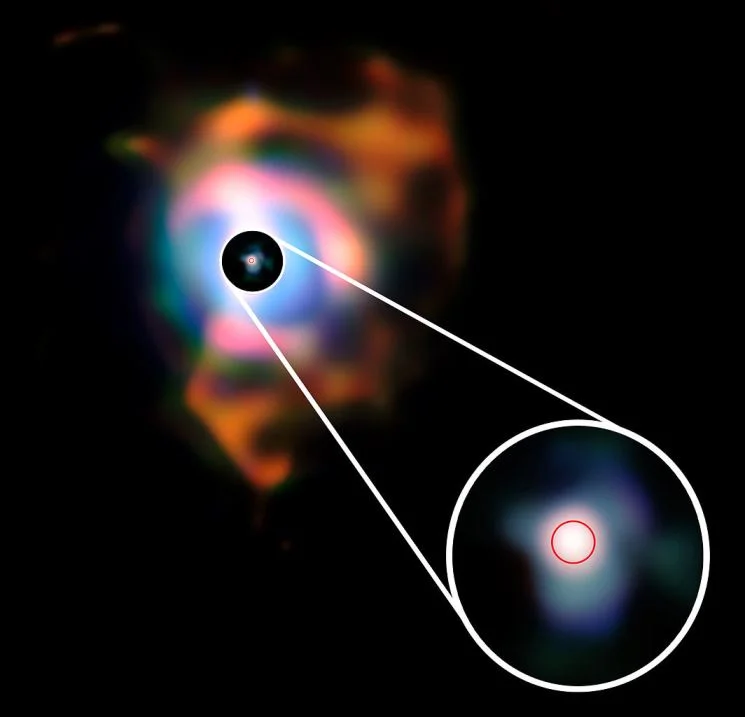
This picture of the dramatic nebula around the bright red supergiant star Betelgeuse was created from images taken with the VISIR infrared camera on ESO’s Very Large Telescope (VLT). This structure, resembling flames emanating from the star, forms because the behemoth is shedding its material into space. The earlier NACO observations of the plumes are reproduced in the central disc. The small red circle in the middle has a diameter about four and half times that of the Earth’s orbit and represents the location of Betelgeuse’s visible surface. The black disc corresponds to a very bright part of the image that was masked to allow the fainter nebula to be seen. Image: ESO/P. Kervella (CC BY-SA 3.0)
Classified as a pulsating semiregular variable star, Betelgeuse exhibits variations in brightness due to changes in its size and temperature. Its magnitude ranges from 0.0 and 1.6, the largest variation seen in any first-magnitude star.
A comprehensive study published in The Astrophysical Journal in October 2020 examined the star’s properties using observational data and three modelling techniques, and revealed that Betelgeuse was smaller and closer than previously believed.
The data included photometric measurements obtained with the Solar Mass Ejection Imager (SMEI) prior to the Great Dimming in 2019 and 2020. The study had six authors: Meridith Joyce of the Space Telescope Science Institute (STScI) in Baltimore, Shing-Chi Leung of the California Institute of Technology (Caltech) in Pasadena, László Molnár of the Konkoly Observatory in Budapest, Michael Ireland of the Australian National University in Canberra, Chiaki Kobayashi of the University of Hertfordshire in Hatfield, and Ken’ichi Nomoto of the University of Tokyo.
The scientists used Modules for Experiments in Nuclear Astrophysics (MESA) to run evolutionary, asteroseismic and hydrodynamic simulations, and to obtain the most accurate estimates to date of Betelgeuse’s stellar parameters. The simulations placed the star in the early core helium-burning phase of the red supergiant branch.
The researchers derived a radius 764 times that of the Sun (702 – 880 solar radii) and a distance estimate of 548 light-years (499 – 638 ly) with a parallax of 5.95 milliarcseconds. They estimated a mass between 16.5 and 19 times that of Sun, slightly lower than most estimates, and a luminosity 87,000 times that of the Sun.
Additionally, the scientists redefined the star’s two known pulsation periods and detected a third. They found a fundamental period of 416 ± 24 days and discovered another period of 185 ± 14 days. The star has a third pulsation period of 2,050 ± 460 days, previously identified by other researchers.
A 2022 study conducted by an international team of astronomers led by Marco Mittag at the University of Hamburg found a luminosity of 65,000 solar luminosities, considerably lower than previous estimates. The researchers found a clear drop in effective temperature of 80 K between November 2019 and February 2020, coinciding with the minimum of visual brightness during the Great Dimming episode. The study proposed that the cause of the dimming was located in the supergiant’s photosphere.
Size
Betelgeuse has an estimated radius of 764 solar radii. The uncertainty margin is 702 – 880 solar radii. This corresponds to 531.5 million kilometres, or 3.6 astronomical units (Earth – Sun distances). If placed at the center of our solar system, the star would engulf both Earth and Mars.
A previous study estimated a radius 887 solar radii, with a margin of error of 203 R☉. At this size, the star’s surface would come close to the orbit of Jupiter (1,064 – 1,173 solar radii).
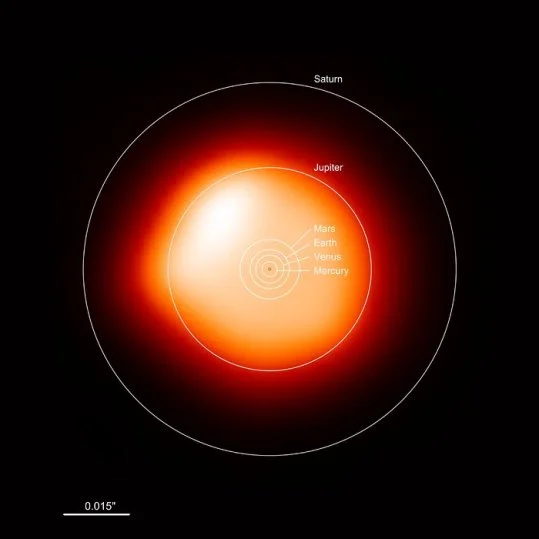
This image, made with the Atacama Large Millimeter/submillimeter Array (ALMA), shows the red supergiant Betelgeuse — one of the largest stars known. In the millimeter continuum the star is around 1400 times larger than our Sun. The overlaid annotation shows how large the star is compared to the Solar System. Betelgeuse would engulf all four terrestrial planets — Mercury, Venus, Earth and Mars — and even the gas giant Jupiter. Only Saturn would be beyond its surface. Credit: ALMA (ESO/NAOJ/NRAO)/E. O’Gorman/P. Kervella (CC BY 4.0)
The star’s precise diameter has been difficult to measure because Betelgeuse is a pulsating variable and its radius keeps changing. There is also a circumstellar envelope of material surrounding the star, a product of increasing mass loss, which makes measurements difficult. As a result, measurements taken at different wavelengths vary by up to 30 to 35%. Limb darkening complicates things even further, with optical emissions varying in colour and fading toward the star’s edge, making the edge hard to define.
However, advances in technology and methodology – mainly in astronomical interferometry – as well as the arrival of space telescopes and observatories (Hipparcos, Hubble and Spitzer), have made it possible to study the star in many different ways and provide some good estimates regarding its properties.
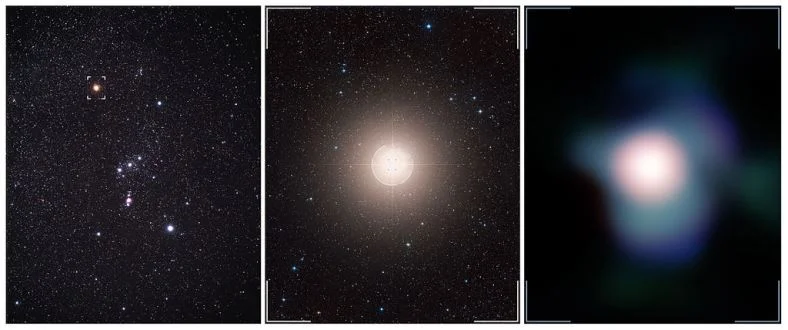
This collage shows the Orion constellation in the sky (Betelgeuse is identified by the marker), a zoom towards Betelgeuse, and the sharpest ever image of this supergiant star, which was obtained with NACO on ESO’s Very Large Telescope., image: ESO, P.Kervella, Digitized Sky Survey 2 and A. Fujii (CC BY 4.0)
In a study published in The Astrophysical Journal in December 2000, measurements of the star’s diameter gave a value of 55.2 ± 0.5 milliarcseconds. At the time, the accepted value for the star’s parallax, obtained from the Hipparcos satellite, was 7.63 ± 1.64 milliarcseconds, giving a radius of 3.6 astronomical units. The measurements were carried out in November 1999 with the Infrared Spatial Interferometer (ISI) at Mount Wilson, California and the findings were not inconsistent with the values given by the American physicist Albert Michelson and astronomers Francis Pease and John Anderson in 1920.
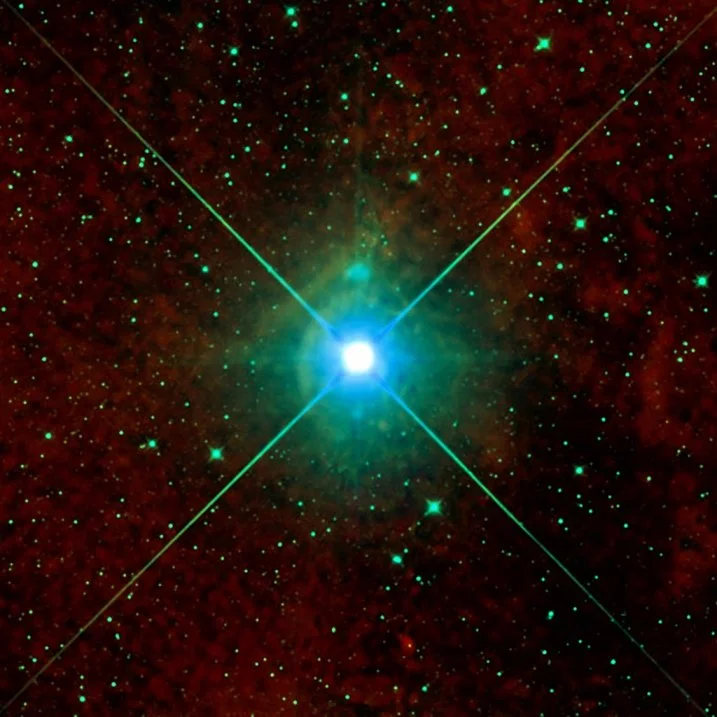
Infrared image of Betelgeuse made using WISE and Akari data, image: Giuseppe Donatiello (CC0 1.0)
However, in 2009, a team at the Space Sciences Laboratory and Department of Physics, University of California, Berkeley, published an infrared interferometric study that revealed that Betelgeuse had shrunk in size by 15% since 1993. Initial measurements revealed a size similar to Michelson’s result, but over the 15 years of observations, the star was shrinking at an increasing rate without showing significant changes in brightness.
The angular measurement in 2008 was 47.0 ± 0.1 milliarcseconds, down from the 56.0 ± 0.1 milliarcseconds observed in 1993. In other words, the star had shrunk by nearly 0.9 astronomical units in 15 years. What is uncertain is whether the measurement reflects the star’s real size, or it is the result of its photosphere expanding and contracting.
Ongoing observations of the star’s mass loss may provide insight into what happens in the last stages of a red supergiant’s evolution that brings about a supernova event.
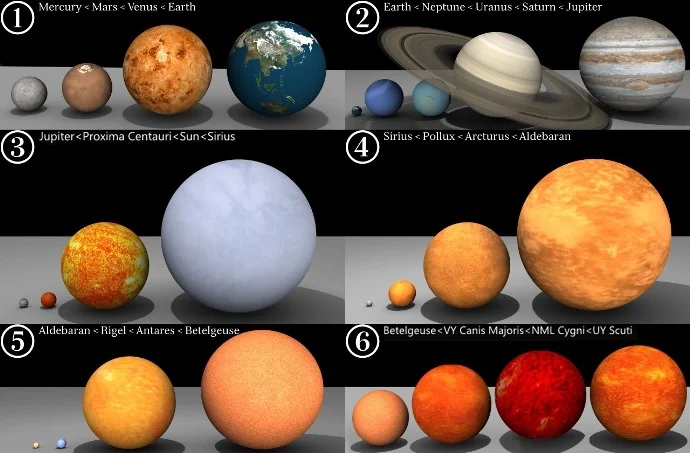
UY Scuti compared to other stars, image: Wikimedia Commons/IStoleThePies (CC BY-SA 4.0)
Subsequent observations with the Berkeley Infrared Spatial Interferometer (ISI) between 2006 and 2009, published in 2011, found a strong variability in the star’s size, effective surface temperature, and the location and degree of asymmetry. The results may indicate an evolving shell of cool, optically thick material near the star’s photosphere that interfered with the measurements.
Images obtained from the Very Large Telescope Interferometer (VLTI), operated by the European Southern Observatory (ESO) in the Atacama Desert in Chile, revealed a complex and asymmetric envelope surrounding the star, with a vast, bright plume of gas extending to a radius of about six times the star’s photosphere (about 30 astronomical units, or the average distance from the Sun to Neptune) in the southwest quadrant. The team of astronomers who made the observations suggested that the plume may be related either to the star’s rotation or to the presence of a convective hot spot on the photosphere.
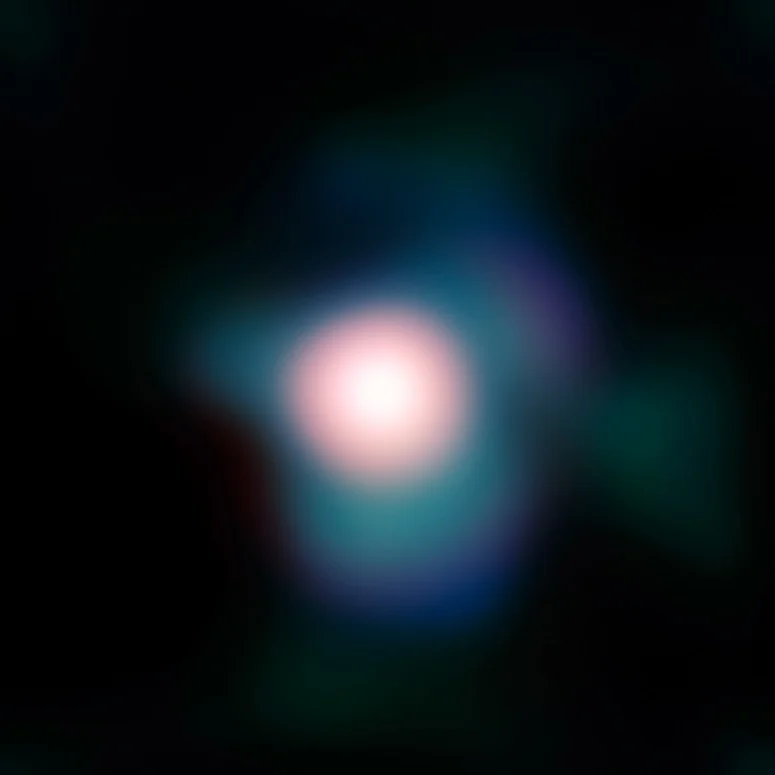
Image of the supergiant star Betelgeuse obtained with the NACO adaptive optics instrument on ESO’s Very Large Telescope. The use of NACO combined with a so-called “lucky imaging” technique, allowed the astronomers to obtain the sharpest ever image of Betelgeuse, even with Earth’s turbulent, image-distorting atmosphere in the way. The resolution is as fine as 37 milliarcseconds, which is roughly the size of a tennis ball on the International Space Station (ISS), as seen from the ground. The image is based on data obtained in the near-infrared, through different filters. The field of view is about half an arcsecond wide, North is up, East is left. Credit: ESO/P. Kervella (CC BY 3.0)
A 2022 study found that the luminosity decrease during the Great Dimming was too large to be accounted for by the lower effective temperature alone. The authors proposed that the radius of Betelgeuse would have had to decrease from around 640 solar radii in November 2019 to around 500 solar radii in January 2020.
Brightness
Betelgeuse usually shines at magnitude 0.5 and varies in brightness only slightly. However, it has been observed to brighten to magnitude 0.0 and dim to magnitude +1.6. The period of variations given for Betelgeuse in the General Catalogue for Variable Stars (GCVS) is 2,335 days.
Betelgeuse is a semiregular variable star, classified in the subgroup SRc, which also includes Mu Cephei (Herschel’s Garnet Star), RW Cygni, VX Sagittarii, and CE Tauri. These variables are cool luminous stars of late spectral classes – mostly pulsating red supergiants – that show variations of about 1 magnitude over periods that range from 30 days to several thousand days.
A detailed study published in October 2006 analyzed brightness variations of red supergiants using data collected by the American Association of Variable Star Observers (AAVSO) over the last century. The study revealed that Betelgeuse showed two different time scales of variations, a slow one lasting a few thousand days and a faster one of several hundred days.
During the observations, Betelgeuse showed two distinct periods, one of 388 ± 30 days and another of 2,050 ± 460 days. The variable red supergiant TV Geminorum in the constellation Gemini showed similar periods.
The shorter periods are believed to be the result of fundamental and first overtone pulsations, while the source of the longer periods is unknown, but it is not related to radial pulsations. Various theories suggest that the longer periods are caused by the evolution of massive convection cells in combination with the star’s rotation, interactions with a close companion, non-radial g-modes, or chromospheric magnetic activity.
The visual magnitude of Betelgeuse varies between magnitude 0.0 and +1.6. At times the star rivals Vega (Alpha Lyrae) and Capella (Alpha Aurigae), the fifth and sixth brightest stars in the sky, while at other times it is fainter than Deneb (Alpha Cygni) and Mimosa (Beta Crucis), the 19th and 20th brightest stars.
If we could see at all wavelengths, Betelgeuse would be the brightest star in the sky. Only 13% of its energy is emitted in visible light, but it is the brightest near-infrared source in the sky. Its J-band magnitude of -2.99 puts it ahead of Antares (-2.7), R Doradus (-2.6), Arcturus (-2.2), and Aldebaran (-2.1).
Betelgeuse’s variability has probably been known since antiquity, but the first person to give an account of it was the English astronomer and mathematician Sir John Herschel in 1836. Herschel observed the star from the 1830s to the 1860s and noticed that its brightness varied significantly. Betelgeuse outshone Rigel twice in the 1830s – in October 1837 and November 1839 – and then, after a quiet decade, its variability peaked again in 1852. In December of that year, Herschel described the supergiant as the brightest star in the northern hemisphere.
Based on the data from the American Association of Variable Star Observers (AAVSO), Betelgeuse reached maximum brightness in 1933 and 1942, peaking at magnitude 0.2, and prior to the Great Dimming in 2019 and 2020 it was at its faintest in 1927 and 1941, dropping to magnitude 1.2.
In April 2023, Betelgeuse reached a peak magnitude of 0.0, briefly outshining Vega and Capella to become the fifth brightest star in the sky.
The star’s variability is likely the reason why German uranographer Johann Bayer assigned it the Greek letter Alpha in his Uranometria (1603). Betelgeuse may have been brighter than Rigel (Beta Orionis) at the time.
Great Dimming (2019 – 2020)
In 2019, the brightness of Betelgeuse started fading and reached a minimum when the low points of its two main pulsational cycles (430 days and 6 years) coincided. The dimming was first noted by astronomers Richard Wasatonic and Edward Guinan at Villanova University in Pennsylvania. They were the first to propose that the dimming was due to the simultaneous 5.9-year light cycle minimum and a deeper 425-day period. Other astronomers speculated that the star was fading due to changes in its surface brightness or an eruption of dust or gas.
Observations with the Hubble Space Telescope (HST) in ultraviolet light indicated that an enormous amount of material was expelled from the star, leading to a decrease in brightness. As the material cooled, it formed a cloud of dust that obscured the light coming from about a quarter of the star’s surface. The cloud of dense material was detected by Hubble in September, October, and November 2019.
In December 2019 and early 2020, a more pronounced fading was observed by several telescopes. Betelgeuse went from being a first-magnitude to a second-magnitude star, fainter than Aldebaran, Antares, Castor, Pollux, and Shaula.
The supergiant dimmed from magnitude 0.5 to 1.5 by January 2020 – by a factor of about 2.5 – and continued to fade. Astronomers reported a record minimum of 1.614 around February 7 – 13. This led to popular speculation that the star would soon go out as a supernova. However, astronomers pointed out that the supernova would occur within the next 100,000 years and that imminent core collapse seemed unlikely.
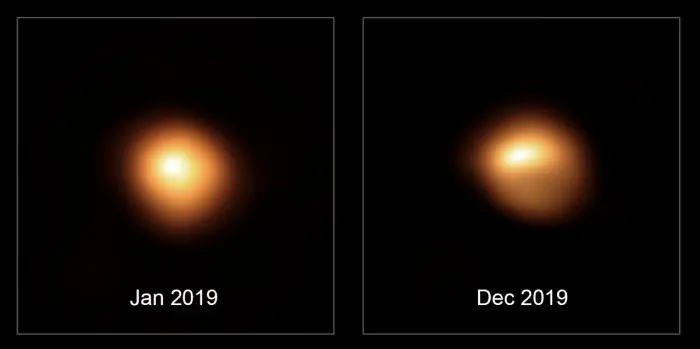
This comparison image shows the star Betelgeuse before and after its unprecedented dimming. The observations, taken with the SPHERE instrument on ESO’s Very Large Telescope in January and December 2019, show how much the star has faded and how its apparent shape has changed. Image: ESO/M. Montargès et al. (CC BY 4.0)
The star’s light stopped fading by February 17, 2020. At first, it remained constant for 10 days and then started increasing. The dimming episode was over on February 22.
In late March, astronomers reported that Betelgeuse was rapidly brightening again, at an average rate of 0.02 magnitudes per day. The observations were reported in The Astronomer’s Telegram on March 31, when the star shone at magnitude 0.93. It was returning to its normal brightness.
Betelgeuse had brightened to magnitude 0.4 in April before it entered its conjunction with the Sun, which makes it invisible for a couple of months every year. The supergiant was observed with NASA’s Solar TErrestrial RElations Observatory (STEREO) spacecraft during the conjunction in June and July and it faded by 0.5 magnitudes since April. This came as a surprise because the star was expected to reach a maximum in August or September.
In late August, astronomers reported a second dust cloud expelled from Betelgeuse, associated with a more recent fading.
Submillimetre observations with the James Clerk Maxwell Telescope (JCMT) at Mauna Kea Observatory in Hawaii and Atacama Pathfinder Experiment (APEX) in Chile’s Atacama Desert showed that the star had also dimmed by about 20% in these longer wavelengths when it was at an optical minimum. The researchers suggested that the dimming may be due to changes in the photosphere (large star spots) rather than dust absorption.
Dr. Phil Massey at the Lowell Observatory in Flagstaff, Arizona, and Dr. Emily Levesque of the University of Washington ruled out star spots as an explanation because the temperature of Betelgeuse had been mostly unchanged since 2003. They suspected that large surface mass ejections were responsible for the dimming.
Observations with the European Southern Observatory’s Very Large Telescope (VLT), reported in Nature in June 2021, showed that the star’s southern hemisphere was ten times darker than usual.
A team of astronomers led by Miguel Montargès from the Observatoire de Paris, France and KU Leuven Institute of Astronomy, Belgium, published new images of the star. The images showed the surface of Betelgeuse, revealing how the star’s brightness had changed. The researchers used the SPHERE instrument on ESO’s VLT to resolve surface details of Betelgeuse, as well as data from the GRAVITY instrument on ESO’s Very Large Telescope Interferometer (VLTI) to observe the star during the dimming episode.
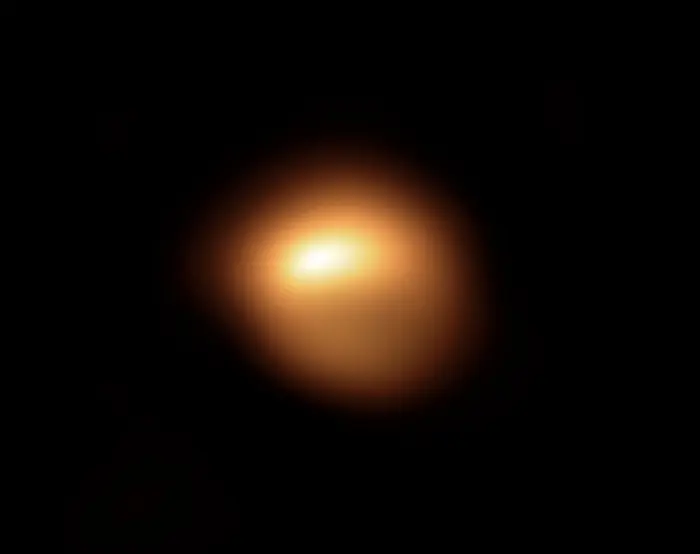
The red supergiant star Betelgeuse, in the constellation of Orion, has been undergoing unprecedented dimming. This stunning image of the star’s surface, taken with the SPHERE instrument on ESO’s Very Large Telescope late last year, is among the first observations to come out of an observing campaign aimed at understanding why the star is becoming fainter. When compared with the image taken in January 2019, it shows how much the star has faded and how its apparent shape has changed. Image credit: ESO/M. Montargès et al. (CC BY 4.0)
The research suggested that Betelgeuse was partly concealed by a dust cloud. The dust cloud was a product of a drop in temperature on Betelgeuse’s stellar surface. A gas cloud was ejected from the star some time before the fading episode. Once a patch of the surface subsequently cooled down, the temperature decrease condensed the gas into solid dust. In essence, it was the formation of stardust that led to Betelgeuse’s Great Dimming.
Emily Cannon, a researcher at KU Leuven, explained that the same dust may eventually be used as the building blocks of terrestrial planets. The study confirmed that a spectacular supernova explosion was not yet imminent.
In 2022, a group of researchers led by Dr. Andrea Dupree at the Harvard & Smithsonian Center for Astrophysics in Cambridge, Massachusetts, released a study that showed that the Great Dimming of Betelgeuse was caused by a coronal mass ejection (CME), an enormous release of plasma and accompanying magnetic field from the star’s corona (outermost layer of its atmosphere).
Dupree, who had previously used Hubble to resolve hot spots on the surface of Betelgeuse in 1996, capturing the first direct image of a star other than the Sun, estimated that Betelgeuse lost about two times the normal amount of material from its southern region during the outburst, at a rate 30 million times higher than our Sun.
The scientists used imaging and spectroscopic observations of the star to reveal that a substantial surface mass ejection (SME) had occurred and moved out through the supergiant’s extended atmosphere. The huge mass ejection of the surface of the star left the photosphere with lower temperatures and the chromosphere with a lower density. The 400-day pulsation period disappeared in the optical and radial velocity for more than two years after the event.
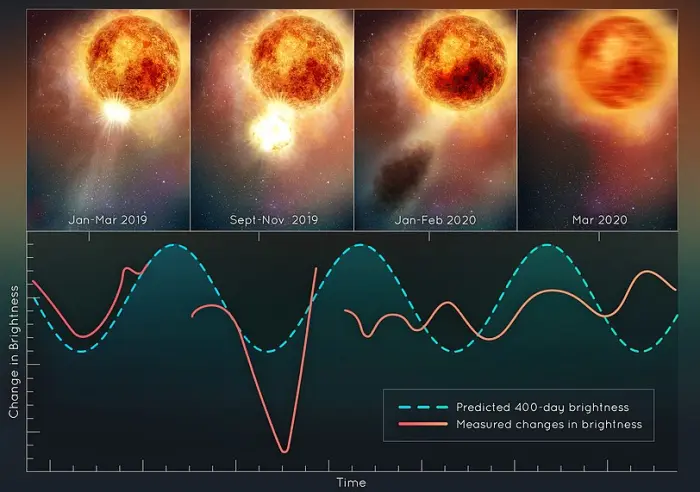
This illustration plots changes in the brightness of the red supergiant star Betelgeuse, following the titanic mass ejection of a large piece of its visible surface. The escaping material cooled to form a cloud of dust that temporarily made the star look dimmer, as seen from Earth. This unprecedented stellar convulsion disrupted the monster star’s 400-day-long oscillation period that astronomers had measured for more than 200 years. The interior may now be jiggling like a plate of gelatin dessert. Illustration: NASA, ESA, Elizabeth Wheatley (STScI) (PD)
The astronomers explained that the dimming may have been caused by a convective plume. The star has very large convective cells on its surface. In 2019, its outward expansion lasted for an unusually long time and coincided with the presence of an unusually large convective cell. Hot plasma surged from an upwelling of the convection cell and passed through the star’s atmosphere to the colder outer layers, where it formed dust as its temperature decreased.
The observed dimming was the result of an ejection of a substantial part of Betelgeuse’s surface, followed by the appearance of a cooler spot as the gas expanded to fill the void. The material that was expelled and cooled combined with the cooler spot caused the visual fading of the star.
In August 2022, researchers at the Harvard-Smithsonian Center for Astrophysics reported that Betelgeuse was slowly recovering from losing a substantial part of its surface. Andrea Dupree and her colleagues analyzed spectroscopic and imaging data obtained from the American Association of Variable Star Observers (AAVSO), the STELLA robotic observatory, the Fred L. Whipple Observatory’s Tillinghast Reflector Echelle Spectrograph (TRES), NASA’s Solar Terrestrial Relations Observatory spacecraft (STEREO-A), and the Hubble Space Telescope (HST). The data will help them understand the effects of a huge mass ejection of a star’s surface, which is something that has not been observed before in real time.
NASA and ESA’s James Webb Space Telescope (JWST) may be able to capture the material expelled from Betelgeuse in infrared light as it continues to speed away from the star.
Chance observations with the Himawari-8 meteorological satellite between 2017 and 2021 confirmed that the dramatic fading was caused both by a drop in effective temperature and increased dust extinction. The cooling and the formation of the dust cloud contributed almost equally to the dimming.
The Japanese weather satellite captured Betelgeuse at multiple infrared wavelengths about once every 1.72 days from its geostationary orbit. The supergiant’s mid-infrared light curves showed that the increased circumstellar extinction contributed to the fading. The data obtained by the satellite is consistent with the popular theory that Betelgeuse ejected a hot clump of gas, which cooled when it came close to a lower-temperature spot on the supergiant and then condensed into dust. The dust obscured the view of the star, causing its visual brightness to decrease.
The data obtained with the Himawari-8 satellite also suggests that there were changes in the supergiant’s atmosphere 10 months before it started to fade. The water molecules that usually create absorption lines in Betelgeuse’s spectrum changed to form emission lines instead, indicating that they were energized.
A team of astronomers and meteorologists led by Daisuke Taniguchi of the University of Tokyo proposed that an irregular pulsation may have caused the decrease in temperature and the formation of a shockwave that resulted in a gas cloud being expelled from the star. The shockwave may have passed through the gas cloud and excited the molecules. The study was published in Nature Astronomy in 2022.
In April 2023, the supergiant was reported to shine at 156% of its usual brightness, reaching magnitude 0.0, and exhibiting brightness variations over 200-day intervals, twice as fast as normally. It became the seventh brightest star in the sky, outshining Achernar, Procyon and its Orion neighbour Rigel. Astronomers believe that Betelgeuse will take another five to 10 years to return to its usual 400-day cycles.

Betelgeuse, image: Wikisky (DSS2)
Colour
With a B-V colour index of 1.85, Betelgeuse is distinctly red. The star and its distinctive red colour have been documented since ancient times. The Greco-Roman astronomer Ptolemy described Betelgeuse as “the bright, reddish star on the right shoulder” in his Almagest in the 2nd century CE.
However, three centuries earlier, Chinese astronomers made a reference to the star’s yellow colour. If their observations were correct, this could indicate that Betelgeuse was not a red supergiant at the time, but still in the yellow supergiant stage of stellar evolution.
Italian astronomer Angelo Secchi, a pioneer in astronomical spectroscopy, collected the spectra of about 4,000 stars in the 19th century and developed the first system of stellar classification. He named Betelgeuse one of the prototypes for his Class III stars. These were stars orange to red in colour, corresponding to what we know today as class M. Antares in Scorpius was the other prototype for the class.
A 2022 study of the colour evolution of Betelgeuse and Antares used historical records to create a 2,000-year timeline of the supergiants’ evolution. The study revealed that Betelgeuse changed colour in historical time. It was documented as yellow two millennia ago.
The Roman author Hyginus (c. 64 BCE – 17 CE) and Chinese historian Sima Qian (c. 145 – 86 BCE) compared the star’s appearance to that of Saturn, describing it as yellow. The Greek astronomer Ptolemy (2nd century CE) did not include Betelgeuse on his list of red stars visible to the unaided eye. He described it as hypokirros, which can mean anything from pale yellow to reddish.
The colour change indicates that the star is likely less than a millennium past the bottom of the red giant branch. The study authors, led by astrophysicist Ralph Neuhäuser (Astrophysical Institute and University Observatory at the Friedrich Schiller University of Jena in Germany), used evolutionary tracks to derive an approximate mass of 14 solar masses and an age of about 14 million years. The study was published in the Monthly Notices of the Royal Astronomical Society. It suggests that the supernova deadline for Betelgeuse may be a bit longer than the widely accepted 100,000 years.
Mass
Betelgeuse has an estimated mass between 14 and 19 solar masses. The star is in the late stage of its life and, like other evolved massive stars, it is losing mass at a high rate, possibly up to 1 solar mass every 10,000 years.
Betelgeuse is not losing mass evenly, which is evident in the large plume of gas extending across a distance six or more times the star’s radius. The uneven mass loss is suspected to be caused either by very large convection cells in the star’s photosphere or by mass loss along polar plumes, possibly as a result of rotation.
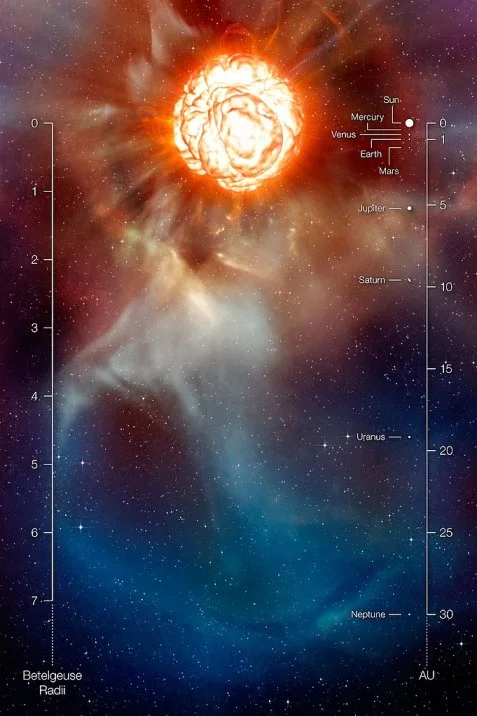
This artist’s impression shows the supergiant star Betelgeuse as it was revealed thanks to different state-of-the-art techniques on ESO’s Very Large Telescope, which allowed two independent teams of astronomers to obtain the sharpest ever views of the supergiant star Betelgeuse. They show that the star has a vast plume of gas almost as large as our Solar System and a gigantic bubble boiling on its surface. These discoveries provide important clues to help explain how these mammoths shed material at such a tremendous rate. The scale in units of the radius of Betelgeuse as well as a comparison with the Solar System is also provided. Image: ESO/L. Calçada (CC BY 4.0)
Modern estimates of the star’s mass have been in the range from 9.5 to 21 solar masses. The star’s initial mass is believed to have been between 15 and 20 solar masses, based on its estimated luminosity of 90,000 to 150,000 solar luminosities.
In 2011, a team of astronomers from the University of Bonn, University of Toronto, and University of São Paulo calculated a mass of 11.6 solar masses (allowing for error in the range from 7.7 to 16.6 solar masses), with an effective temperature of 3,590 ± 55 K, an angular diameter of 44.93 ± 0.15 milliarcseconds, and a radius of 955 ± 217 solar radii.
In 2016, a study using evolutionary models and adopting the VLA-Hipparcos distance of 197 ± 45 parsecs estimated a progenitor mass of 20 solar masses (17 – 25 solar masses), a current mass of 19.4 – 19.7 solar masses, a radius of 887 ± 203 solar radii, and a current age between 8 and 8.5 million years.
Companion
Betelgeuse has long been considered a single star. As a runaway star, the supergiant is not associated with any stellar association, cluster or stellar nursery.
However, astronomers have proposed the presence of companions for decades. In 1985, they proposed two spectroscopic companions based on an analysis of polarization data obtained from 1968 to 1983. The companions would have been at a separation of 0.06 and 0.51 arcseconds, corresponding to a physical distance of 9 and 77 astronomical units. However, later observations, including high-resolution interferometry, found no evidence of close companions.
In 2024, a study proposed the existence of a low-mass companion as the most plausible explanation for the 2,170-day long secondary period (LSP) in the supergiant’s lightcurve. The period is around five times longer than Betelgeuse’s fundamental radial pulsation mode (416 days).
The study was authored by Jared A. Goldberg of the Center for Computational Astrophysics in New York, NY, Meridith Joyce at the University of Wyoming and László Molnár of the Research Centre for Astronomy and Earth Sciences in Hungary.
The candidate for Alpha Orionis B would have a mass of 1.17 ± 0.7 solar masses and orbit the supergiant at a separation of 1,850 ± 70 solar radii. The presence of the companion that impacts the surrounding dust would be a plausible explanation for the LSP. As the companion came into view from Earth, it would disperse the clouds that obscure Betelgeuse, temporarily causing an increase in brightness.
Betelgeuse is one of many long period variables with a long secondary period. The presence of a binary companion star is one of the possible causes for these periods, along with rotation, dust formation, giant cell convection, and non-radial oscillations. However, the causes of the long secondary periods have not been identified with any certainty.
Distance
Betelgeuse lies approximately 548 light-years away, with a margin of error between 499 and 638 light-years. After Rigel, Orion‘s brightest star, Betelgeuse is the most distant of the 10 brightest stars in the sky.
The distance of 548 light-years comes from a 2020 study that combined evolutionary, asteroseismic and hydrodynamical simulations with the Modules for Experiments in Stellar Astrophysics (MESA) software suite. The study authors used data collected by the American Association of Variable Star Observers (AAVSO) and photometry from the Solar Mass Ejection Imager Instrument (SMEI) aboard the Coriolis spacecraft.
The previously accepted distance for Betelgeuse was between 643 and 724 light years. Since the first measurements were made in 1920, estimates of the star’s distance were as high as 1,300 light-years (400 parsecs), but more recent studies indicate that the star is significantly closer to us.
The observations in 1920 yielded a value of about 180 light-years (56 parsecs) with the incorrect parallax of 0.0180 arcseconds. Before the release of the data collected by the Hipparcos satellite in the 1990s, there were two conflicting values for the star’s parallax, one of 9.8 ± 4.7 milliarcseconds, which gave a distance of about 330 light-years (102 parsecs) and another of 5 ± 4 milliarcseconds and a distance of 650 light-years (200 parsecs).
In 1997, the Hipparcos data was released with the measured parallax of 7.63 ± 1.64 milliarcseconds for Betelgeuse, which yielded a distance of about 430 light-years (131 parsecs). Taking into account the uncertainty of the data collected for variable stars, this value was recalculated to 6.55 ± 0.83 milliarcseconds, giving a distance of 520 ± 73 light-years (152 ± 20 parsecs).
Observations with the Very Large Array (VLA) in 2008 yielded a value of 5.07 ± 1.10 mas, with a distance of 643 ± 146 light-years (197 ± 45 parsecs).
More recent observations combining the VLA and new e-MERLIN and ALMA radio positions with the 2007 Hipparcos Intermediate Astrometric Data (HIAD), using data collected over 34 years (1982-2016) and including radio Cosmic Noise of 2.4 mas, produced a parallax of 4.51 ± 0.80 mas, which gives a distance of about 724 light years (222 parsecs), with a margin of error that allows for the range from 567.5 to 864.3 light-years (174 – 256 parsecs).
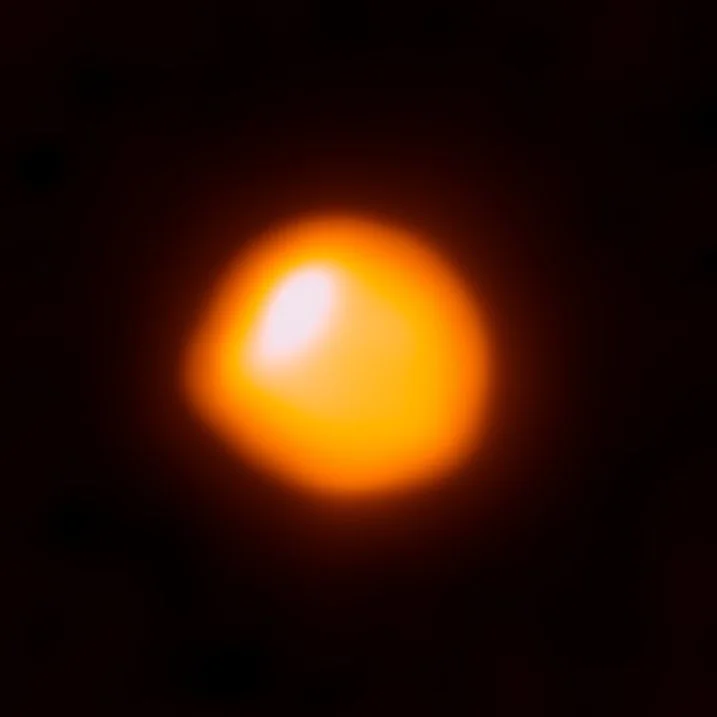
This orange blob shows the nearby star Betelgeuse, as seen by the Atacama Large Millimeter/submillimeter Array (ALMA). This is the first time that ALMA has ever observed the surface of a star and this first attempt has resulted in the highest-resolution image of Betelgeuse available. Betelgeuse is one of the largest stars currently known — with a radius around 1400 times larger than the Sun’s in the millimeter continuum. About 600 light-years away in the constellation of Orion (The Hunter), the red supergiant burns brightly, causing it to have only a short life expectancy. The star is just about eight million years old, but is already on the verge of becoming a supernova. When that happens, the resulting event will be visible from Earth, even in broad daylight. The star has been observed in many other wavelengths, particularly in the visible, infrared, and ultraviolet. Using ESO’s Very Large Telescope astronomers discovered a vast plume of gas almost as large as our Solar System. Astronomers have also found a gigantic bubble that boils away on Betelgeuse’s surface. These features help to explain how the star is shedding gas and dust at tremendous rates (eso0927, eso1121). In this picture, ALMA observes the hot gas of the photosphere of Betelgeuse at sub-millimeter wavelengths — where localised increased temperatures explain why it is not symmetric. Scientifically, ALMA can help us to understand the extended atmospheres of these hot, blazing stars. Image: ALMA (ESO/NAOJ/NRAO)/E. O’Gorman/P. Kervella, 2017 (CC BY 4.0)
Supernova
Betelgeuse is a massive star that will inevitably end its life as a supernova. The red supergiant was once a hot, luminous class O star and, like all massive stars, it will live a short life. Its mass, rotation rate, and other properties will ultimately determine the date and details of its end. The star’s core will eventually collapse, triggering a supernova which will leave behind a dense remnant, either a neutron star of about 1.5 solar masses or a black hole.
The star’s initial mass is uncertain and can only be estimated based on its current properties. Most estimates have been in the range between 10 to 25 solar masses, with recent studies narrowing it down to between 15 and 20 solar masses.
A star with 15 solar masses would take between 11.5 and 15 million years to reach Betelgeuse’s current red supergiant phase, while one with 20 masses would take between 8.1 and 9.3 million years, depending on its rotation rate. (Slow rotators would take less time, while fast spinners would take the longest.)
It is also uncertain how long the star has been a red supergiant, with estimates ranging between 20,000 years and 140,000 years. A study published in 2016 using evolutionary models estimated an initial mass of 20 solar masses and an age of 8.5 million years, concluding that Betelgeuse has only recently begun burning helium and will likely begin carbon burning within 100,000 years and go out as a supernova shortly thereafter.
If the star goes supernova in the current red supergiant stage, it will likely produce a type II-P supernova. If it first passes through another yellow supergiant stage and evolves blueward (into a blue supergiant or a Wolf-Rayet star), it may go out as a type II-L supernova. If it meets its end as a type II-P supernova, the event will have an estimated magnitude of -12.4, possibly outshining the full Moon for a couple of months before rapidly dimming.
The exact date of the supernova event cannot be predicted. How much time Betelgeuse has left depends on its initial properties and on the time it has already spent as a red supergiant. The total time from the beginning of the red supergiant stage to the collapse of the core varies from 300,000 years to up to a million years. The model for a non-rotating star with 20 solar masses predicts less than 100,000 years while rotating or lower-mass stars would take considerably longer.
When Betelgeuse does finally meet its end, the supernova will not affect the solar system because the star is too distant for its expelled material and ultraviolet or X-ray radiation to affect us.
Facts
Betelgeuse has the second largest apparent size of all stars except the Sun and R Doradus, a red giant star in the southern constellation Dorado, classified as a Mira variable. Betelgeuse was the star with the largest angular diameter known until 1997, when the diameter measurements of R Doradus produced a value of 57.0 ± 0.5 mas.
Betelgeuse was the first star other than the Sun to have the angular size of its photosphere measured. In 1920, American physicist Albert Michelson and astronomers Francis Pease and John Anderson used a 6-metre interferometer with the 2.5-metre telescope at the Mount Wilson Observatory in California to measure the star’s angular diameter. They got the value of 0.047 arcseconds, which translated into a diameter of 2.58 astronomical units using the parallax value of 0.018 arcseconds. However, the results of their measurements were not dependable. Later observations yielded an angular diameter between 0.042 and 0.056 arcseconds.
Betelgeuse is one of the four Orion stars selected for use in the field of celestial navigation. The other three navigational stars in the constellation are Rigel, Bellatrix, and Alnilam.
In 2023, a team of astronomers proposed that Betelgeuse did not start its life as a single star but may instead be the product of a quiet merger between a massive star and a main sequence companion. The supergiant has unusual properties, such as an abundance of nitrogen it its outer atmosphere, and it spins at a much higher rate than other red supergiants.
The team used three-dimensional hydrodynamic simulations of a merger between a star with a mass of 16 solar masses, evolving into a supergiant, and a main sequence star with a mass of 4 solar masses. As the more evolved star expanded, the companion accreted some of its material and increased its own mass. Eventually, the companion was slowed down and pulled inward, and it merged with the supergiant’s helium core.
The merger resulted in an enormous ejection of material. The material from the companion briefly returned the supergiant to the hydrogen core fusing phase before it evolved into a red supergiant again. The merger sent nitrogen into the supergiant’s outer atmosphere and increased its spin rate. The simulation showed a post-merger star that still spins rapidly and has a similar chemical composition to Betelgeuse. The theory will not be confirmed until Betelgeuse goes out as a supernova, giving astronomers an opportunity to study its chemical makeup.
A 2023 study proposed that Betelgeuse may not be spinning at 5 km/s at all, but that the dipolar velocity field that was interpreted as evidence for its spin rate may be due to large-scale convective motions, which can be mistaken for rotation. The study authors concluded that more ALMA observations were needed to establish whether or not Betelgeuse is rapidly spinning.
Studies in the late 1980s and 1990s brought the first images of Betelgeuse’s stellar disk in optical and infrared wavelengths. These were the first such images of a star other than the Sun.
In February 1989, high-resolution images of Betelgeuse revealed an asymmetric feature on its surface, possibly the result of a close companion passing in front of it or due to convection in the star’s atmosphere. The images were part of a study conducted by a team of astronomers at the Mullard Radio Astronomy Observatory in Cambridge and the Palomar Observatory in California.
Interferometric observations from the Royal Greenwich Observatory and the Mullard Radio Astronomy Observatory carried out over eight weeks between November 1994 and January 1995 showed complex asymmetries in the star’s brightness distribution and at least three bright spots changing positions during the observation period, indicating convective surface hotspots. The observations also revealed the presence of a dust halo at least 0.3 arcseconds across.
A study published in 1997, conducted in 1995 by a team at the Mullard Radio Astronomy Observatory and the lnstitute of Astronomy in Cambridge, did not find evidence of the brightness asymmetries, only a strongly limb-darkened, but symmetric disc. (Limb darkening is a gradual decrease in the brightness of a stellar disk seen from the centre to the limb or edge.)
In 1995, the Hubble Space Telescope captured the first direct image of the star’s disk. The ultraviolet image had a significantly better resolution than those taken by ground-based telescopes. The image confirmed the presence of a bright patch in the southwest quadrant, strongly suggesting that there was a region about 2,000 K hotter than the star’s surface.
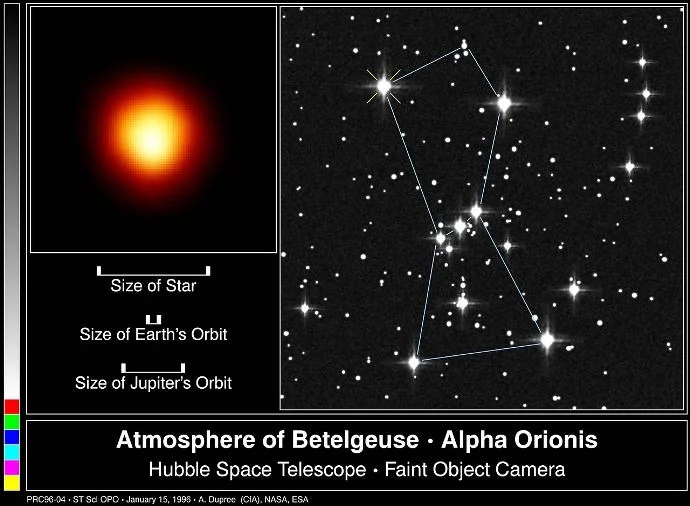
This is the first direct image of a star other than the Sun. Called Alpha Orionis, or Betelgeuse, the star is a red super giant, a Sun-like star nearing the end of its life. The Hubble picture reveals a huge ultraviolet atmosphere with a mysterious hot spot on the stellar behemoth’s surface. The enormous bright spot, twice the diameter of the Earth’s orbit, is at least 2,000 degrees Kelvin hotter than the star’s surface. Image: Andrea Dupree (Harvard-Smithsonian CfA), Ronald Gilliland (STScI), NASA and ESA (PD)
Ultraviolet spectra obtained with the Goddard High Resolution Spectrograph on board the Hubble Space Telescope indicated that the region was located at one of the star’s poles of rotation. If this is accurate, the rotational axis is inclined about 20° to our line of sight. The observations also yielded a rotation period of 17 years, with a rotational speed of 1.2 × 10-8 rad s-1.
Betelgeuse is surrounded by an intricate envelope about 250 times the star’s size, composed of material lost from the star. The vast dust and gas shells extend almost 20,000 astronomical units away from the star. The star’s extended atmosphere and radial pulsations make it difficult to measure the star’s diameter with any degree of certainty.
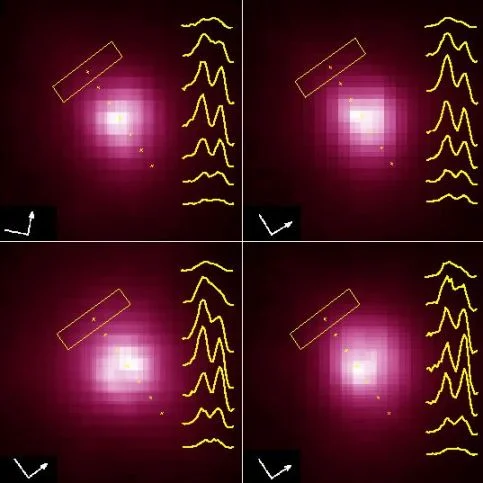
Image showing the red supergiant Betelgeuse that pulsates, swells and shrinks asymmetrically, credit: Andrea Dupree, Ronald Gilliland, CfA, STScI, NASA, ESA (PD)
The known components of the star’s atmosphere are the photosphere (the outer shell or visible surface), the MOLsphere (the molecular region stretching for 2-3 astronomical units above the photosphere, between the photosphere and the expanding shell), an envelope of gas, the chromosphere (the gaseous layer above the photosphere whose spectrum is dominated by emission lines), a region of dust and two carbon monoxide shells.
Betelgeuse’s MOLsphere is known to be composed of carbon monoxide and water vapour, first detected in the 1960s.
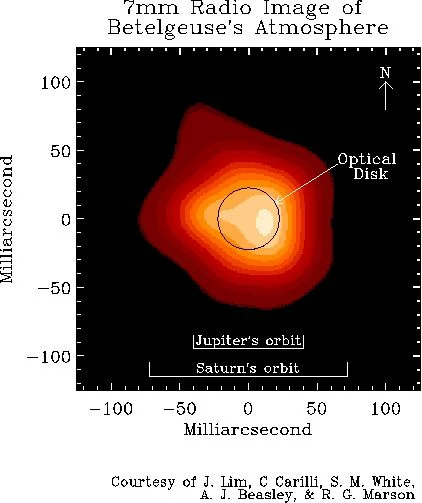
Radio image of Betelgeuse’s atmosphere – propelled by convective forces, the star’s atmosphere can expand beyond the orbit of Saturn. Image: NRAO/AUI and J. Lim, C. Carilli, S.M. White, A.J. Beasley, and R.G. Marson (CC BY 3.0)
The gaseous envelope extends for about 10 to 40 astronomical units from the photosphere and is asymmetrical.
Radio-telescope observations in 1998 confirmed that Betelgeuse has a dense and very complex atmosphere that is many times larger than the star itself. They also showed that most of the gas in the star’s atmosphere has about the same temperature as the gas on the surface and constitutes the largest portion of the atmosphere. The lower-temperature gas cools as it is propelled from the surface into the atmosphere.
Betelgeuse’s chromosphere was imaged in near-ultraviolet wavelengths by the Hubble Space Telescope in 2002. The images revealed that it was accelerating outward. The images also showed warm chromospheric plasma at least an arcsecond away from the star, which overlaps and co-exists with the cool gas in the star’s circumstellar dust envelope.
The dust envelope was given a radius estimate between 0.5 and 1 arcseconds in the 1990s, but as it undergoes constant significant changes, even over shorter periods, different studies have produced very different results.
The size of the two outer carbon monoxide shells is also uncertain, but observations in 2009 detected one shell 1.5 arcseconds west of the star, extending for about 4 arcseconds, while the other is extending to about 7 arcseconds.
Betelgeuse may be one of the most studied stars in the sky, but its birthplace is still a mystery. Projecting Betelgeuse’s motion back in time would put its birthplace at a location without a star-forming region, indicating that the star has changed course at some point. One theory suggests that the star is a runaway member of the Orion OB1 association, a group of several dozen O and B-class stars that includes Alnitak, Alnilam, Mintaka, and the stars in M42 (the Orion Nebula) and M43 (De Mairan’s Nebula).
A study published in March 2008 proposed that Betelgeuse was most likely a member of a multiple star system within the Orion OB1a subgroup. The subgroup is located northwest of Orion’s Belt stars and has an estimated age of 12 million years.
However, a study published in 2015 uncovered a previously unknown group, the Taurion OB association, and proposed that, based on its velocity and proximity to the group, Betelgeuse may belong to this association instead. The Taurion OB association occupies an area of about 20 by 15 degrees in the constellations Orion and Taurus. It includes 36 B stars with an average estimated distance of only 150 parsecs (about 490 light years).
Observations in 2011 showed that Betelgeuse is creating a bow shock as it moves through the interstellar medium at 30 km/s. The bow shock is produced by the star’s strong stellar wind as it collides with the interstellar matter in the star’s way and ejects gas into the interstellar medium at 17 km/s. The bow shock is about three light years in diameter and the mass of the bow shock shell is believed to be low, indicating that it was created relatively recently (in the past 30,000 years) and that Betelgeuse has not been a red supergiant for very long.
Betelgeuse is one of the largest known stars. Its estimated radius (764 R☉) does not come near those of Mu Cephei (mag. 4.08, 1,260 – 1,650 R☉), VV Cephei A (mag. 4.80, 1,050 – 1,900 R☉), or the mostly invisible VY Canis Majoris (mag. 6.5 – 9.6, 1,420 R☉), but Betelgeuse is by far the brightest enormous star in the sky. In comparison, the current size record holders, the red supergiants Stephenson 2-18 and UY Scuti, have estimated radii of 2,150 and 1,708 solar radii respectively.
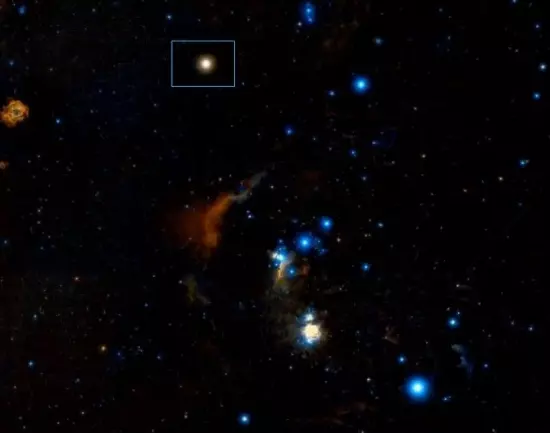
Betelgeuse (Alpha Orionis), image: Wikisky (DSS2)
Betelgeuse has up to nine dim line-of-sight companions at a separation of 1 to 4 minutes of arc. All the stars are fainter than 10th magnitude.
On December 12, 2023, Betelgeuse was occulted by the asteroid 319 Leona. During the occultation, the supergiant almost disappeared as the asteroid passed in front of it. The asteroid did not eclipse the star completely, but it caused a momentary dimming, creating a ring of fire for about 5 seconds.
The event was visible along a narrow path stretching from central Mexico and southern Florida across the Atlantic to southern Europe (including Spain, Italy and Greece), Turkey, and east Asia. The Virtual Telescope Project streamed the event live from Italy. The annular occultation was visible on a 60 km wide path.
The asteroid Leona is a main belt object that orbits the Sun between the planets Mars and Jupiter. The 14th magnitude space rock is about 80 by 55 kilometres (50 by 34 miles) across in size.
The eclipse gave astronomers a unique opportunity to study the supergiant’s photosphere, the outer layer from which the star emits most of its energy, and map its large convective cells, which cause the star to dim and brighten for months at a time.
Betelgeuse is often used or referenced in works of fiction. Its many appearances in literature include H. P. Lovecraft’s The Cthulhu Mythos (1921- ), M. A. R. Barker’s Tékumel novels and games, Philip K. Dick’s short stories “Tony and the Beetles” (1953) and “Shell Game” (1954), Kurt Vonnegut, Jr.’s novel The Sirens of Titan (1959), Pierre Boulle’s Planet of the Apes (1963), Frank Herbert’s Dune series (1965-), Gérard Klein’s Starmasters’ Gambit (Le Gambit des Étoiles, 1958), Douglas Adams’ The Hitchhiker’s Guide to the Galaxy (1978–1993) novels, and Jeffrey Carver’s From a Changeling Star (1989).
In film, Betelgeuse was memorably referenced in Tim Burton’s Beetlejuice (1988) and Beetlejuice Beetlejuice (2024). In Ridley Scott’s Blade Runner (1982), it may have been the star the replicant Roy Batty alluded to as “the shoulder of Orion” in his “Tears in the rain” speech. The other candidate is the blue-white Bellatrix, the left shoulder of Orion.
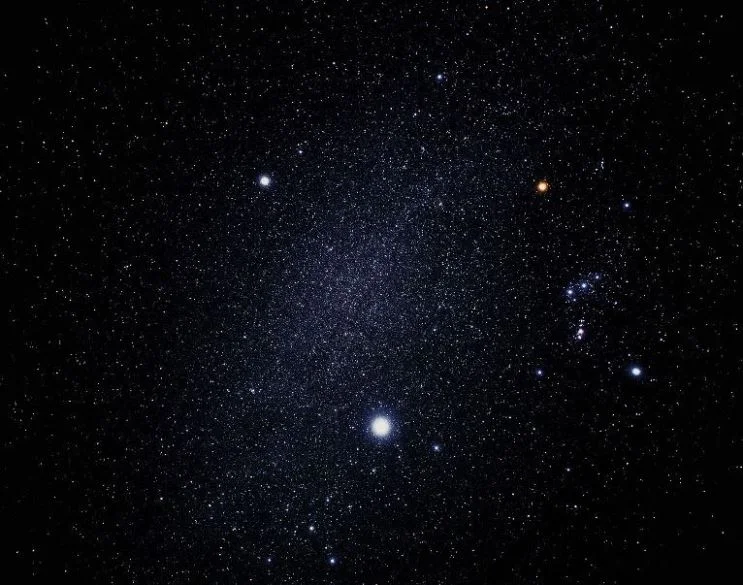
Procyon (upper left), Sirius (botton centre) and Betelgeuse (upper right), image: Hubble/European Space Agency, credit: Akira Fujii (PD)
Name
The name Betelgeuse (English pronunciation: /ˈbɛtəldʒuːz/, /ˈbɛtəldʒuːs/, /ˈbiːtəldʒuːz/ or /ˈbiːtəldʒuːs/) was officially approved for the star Alpha Orionis Aa by the International Astronomical Union’s (IAU) Working Group on Star Names (WGSN) on June 30, 2016.
Betelgeuse is the star’s traditional name. The exact origin of the name is disputed, but it is taken either from the Arabic phrase Ibṭ al-Jauzā’, which means “the armpit of the central one” or from the phrase Yad al-Jauzā’, meaning “the hand of the central one.” Al-jauza is translated as “the central one” or sometimes as “the giant,” while the first part of the phrase refers to the star’s position in the constellation.
The name may also have come from the phrase bait al-jauza, which means “the house of the central one.” Jauza was an old Arabic name for a female constellation figure that encompassed the stars of Orion and the neighbouring constellation Gemini, but the identity of the figure is unknown.
The Chinese knew Betelgeuse as 参宿四 (Shēnxiùsì), the Fourth Star of the Constellation of Three Stars. The constellation originally included only the three stars of Orion’s Belt (Alnitak, Alnilam, and Mintaka), but was later expanded to include other bright stars of Orion. However, the constellation’s original name stuck.
The Inuit call Betelgeuse Ulluriajjuaq, which means “large star.” To observers in Arctic latitudes, Betelgeuse may appear more prominent than Rigel because it rises higher above the horizon. The Inuit called Betelgeuse and Bellatrix Akuttujuuk, meaning “those (two) placed far apart.” The stars’ appearance over the southern horizon signalled the coming of spring.
Betelgeuse has also been known as Bašn (“the Arm”) in Persian, Klaria (“an Armlet”) in Coptic, and Bahu in Sanskrit, referring to the Hindu conception of Orion as a running stag or antelope.
Another Sanskrit name for the star was ārdrā, “the moist one.” Rudra, the god of storms, presided over the star.
In Hawaii, the star’s name was Kaulua-koko, meaning “brilliant red star.” The Lacandon people in Mexico also had a name that reflected the star’s colour. They called it chäk tulix, which means “red butterfly.”
Mythology and culture
Like other exceptionally bright stars, Betelgeuse is part of the folklore and history of many different cultures.
In Japan, the star was chosen as the symbol of the Taira clan, one of the four important clans during the Heian period (794-1185). They called the star Heike-boshi (平家星). The rivalling Minamoto clan chose Rigel as their symbol. The two clans fought the legendary Genpei War and the two stars were seen as facing off against each other, with only the three stars of Orion’s Belt keeping them apart.
The Batak in North Sumatra, Indonesia celebrated the New Year with the first new Moon after Orion’s Belt disappeared below the horizon, when Betelgeuse lingered “like the tail of a rooster” and Antares rose in the east, at the opposite end of the sky. They saw Orion and Scorpius as a pair of scorpions facing toward one another.
Tahitians knew Betelgeuse as Anâ-varu and considered it one of the pillars holding the sky. They also called it Ta’urua-nui-o-Mere, which means “great festivity in parental yearnings.”
Aboriginal Australians in the Great Victoria Desert incorporated the star’s variability into a legend. In the tale, Orion represents Nyeeruna, who creates fire magic in his right hand, represented by Betelgeuse, to reach the Yugarilya sisters (the Pleiades). The eldest sister, Kambugudha, symbolized by the Hyades cluster, kicks sand in his face, dispelling his magic, and stops him from gaining access to the sisters. The process is described as cyclic, with Betelgeuse brightening and fading over time.
The Wardaman people in the Northern Territory of Australia called Betelgeuse Ya-jungin, or “Owl Eyes Flicking.” The star’s variability was associated with the watching of ceremonies led by Unumburrgu (Rigel), the Red Kangaroo Leader.
The Pemon people in Brazil called Orion Zililkawai and the constellation represented a man whose wife cut off his leg. Betelgeuse’s variable brightness was associated with the cutting of the limb. In North America, the Lakora people linked the star with a similar legend, one about a chief whose arm was cut off.
In South African lore, the star is associated with a lion watching three zebras, symbolized by the stars of Orion’s Belt.
In Macedonian folklore, Betelgeuse was linked with Orach, “the ploughman,” and the constellation Orion represented a plough with oxen. Betelgeuse rising before dawn in late summer signalled the time for people to get up and go to the fields to plough.
Location
Betelgeuse is very easy to find because it is one of the brightest stars in the sky and because it is a part of one of the most recognizable constellations. It marks the right shoulder of Orion (Orion’s right shoulder, or the left one from our perspective) and outlines the constellation’s familiar hourglass shape with the bright stars Bellatrix, Rigel, and Saiph. Alnitak, Alnilam and Mintaka form Orion’s Belt, and the fainter Meissa marks the Hunter’s head.
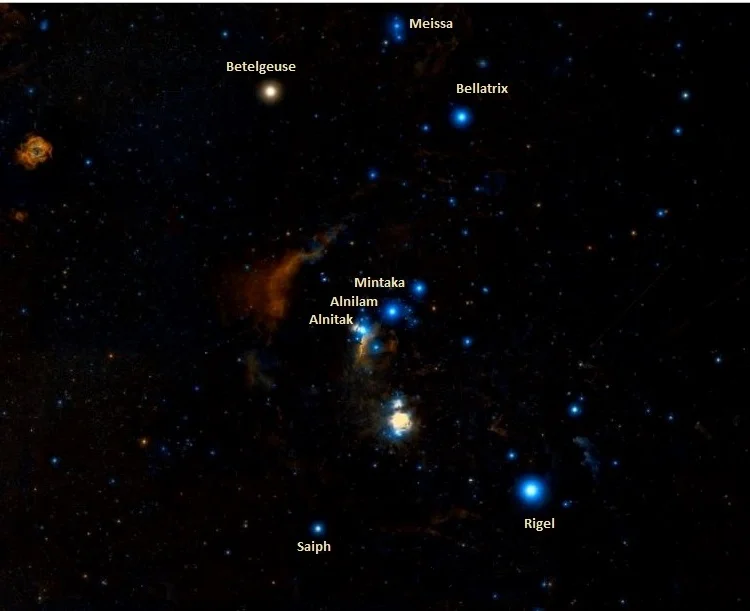
Orion stars, image: Wikisky (DSS2)
Betelgeuse marks the upper right vertex of the Winter Triangle, a prominent asterism that is easy to spot in the sky during the northern hemisphere winter. The other two vertices of the triangle are marked by Sirius, the brightest star in the sky and the luminary of the constellation Canis Major, and Procyon, the brightest star in Canis Minor and the eighth brightest star in the sky. Also known as the Great Southern Triangle, the Winter Triangle dominates the evening sky from December to March.
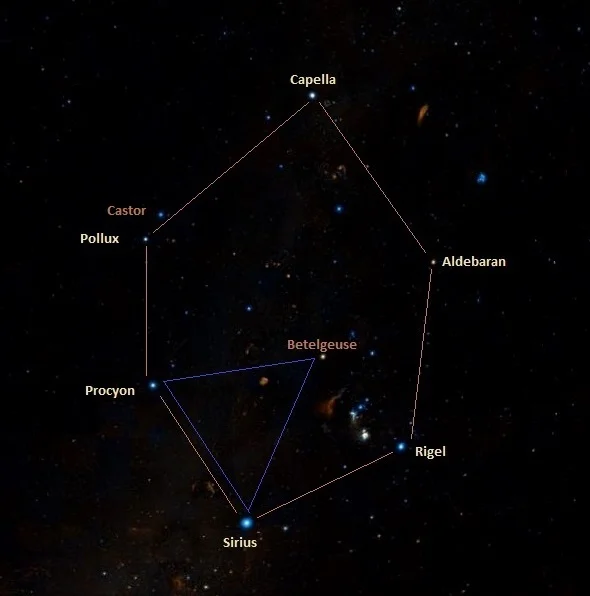
The Winter Triangle and the Winter Hexagon, image: Wikisky (DSS2)
While it is not a part of the Winter Circle (Winter Hexagon), a larger winter asterism that contains the Winter Triangle, Betelgeuse is the brightest star within its borders and can be seen near its centre. The asterism is formed by the bright stars Rigel, Sirius, Procyon, Pollux, Capella, and Aldebaran.
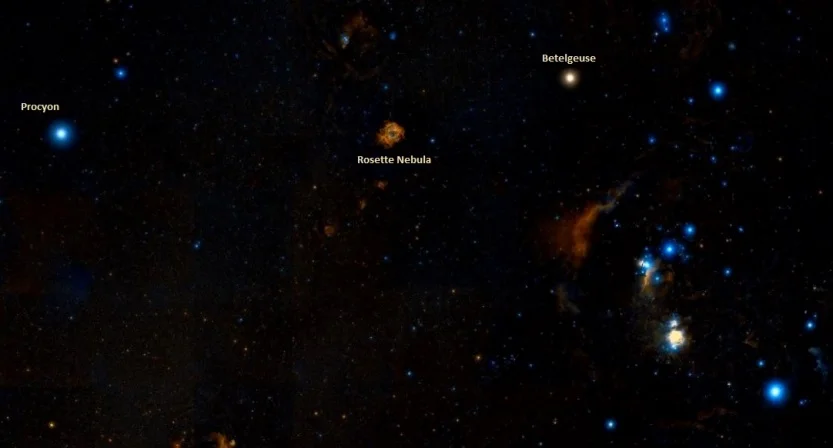
Procyon, Betelgeuse and the Rosette Nebula, image: Wikisky (DSS2)
Betelgeuse is located in the vicinity of several notable deep sky objects. The Rosette Nebula – a large H II region encompassing New General Catalogue designations NGC 2237, NGC 2238, NGC 2239, NGC 2244, and NGC 2246 – is located in the neighbouring constellation Monoceros, the Unicorn, and can be found between Betelgeuse and Procyon in Canis Minor. The Cone Nebula with the Christmas Tree Cluster and the smaller Dreyer’s Nebula (IC 2169) are located in the same area.
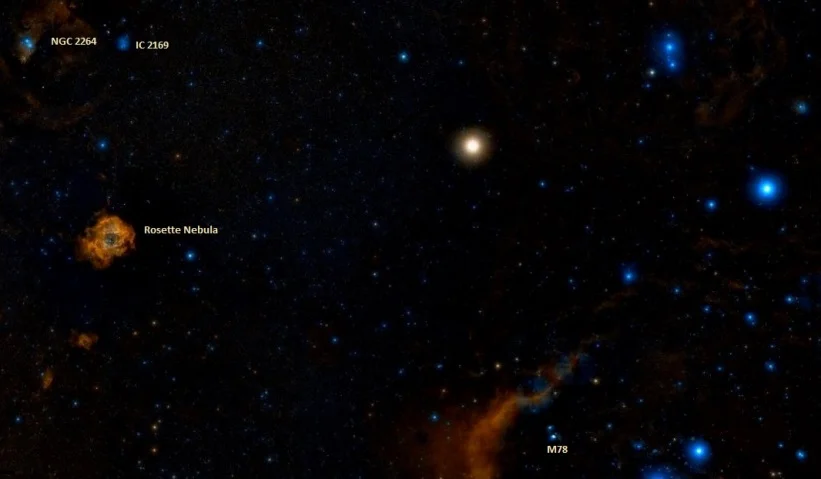
Betelgeuse, the Rosette Nebula, the Cone Nebula, Dreyer’s Nebula, and Messier 78, image: Wikisky (DSS2)
The Lambda Orionis Ring (Angelfish Nebula) and the Lambda Orionis Cluster (Collinder 69) are centred on the star Meissa, Lambda Orionis, which marks Orion’s head and forms a triangle with Betelgeuse and Bellatrix. The planetary nebula NGC 2022, visible in medium-sized telescopes, can be found about two-thirds of the way from Betelgeuse to Meissa.
Constellation
Betelgeuse is located in the constellation Orion, the Hunter. Associated with a hunter, warrior, or giant in many mythologies, the constellation is home to two of the 10 brightest stars in the sky – Rigel and Betelgeuse – and contains a good number of popular targets for backyard telescopes.
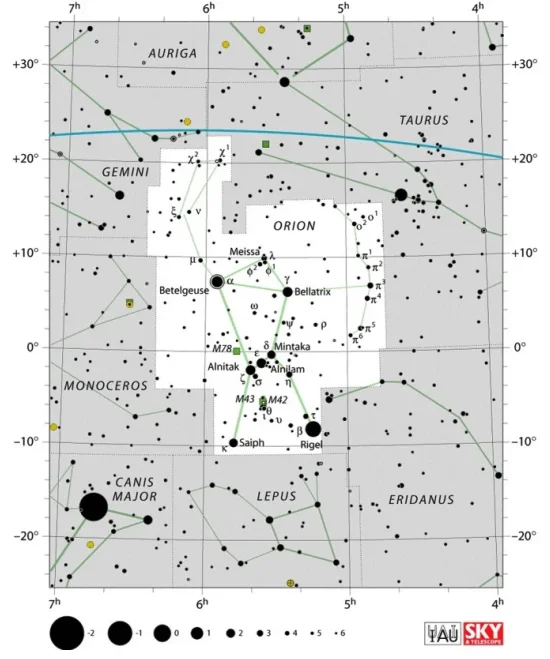
Orion constellation map by IAU and Sky&Telescope magazine
The best-known of these are the Orion Nebula (Messier 42), the nearest massive star-forming region to Earth, containing the young Trapezium Cluster, the neighbouring De Mairan’s Nebula (Messier 43), the reflection nebula Messier 78, the emission nebulae Barnard’s Loop and the Flame Nebula (NGC 2024), and the dark Horsehead Nebula.
Orion also contains one of the best-known asterisms in the sky, Orion’s Belt, formed by the supergiant stars Alnitak and Alnilam and the bright giant Mintaka.
The best time of the year to observe the stars of Orion is during the northern hemisphere winter, when the constellation dominates the evening sky. Betelgeuse is visible from everywhere except south of the latitude 82° S (Antarctica) from mid-September to mid-March. In June and July, it can only be seen with a telescope in daylight, except in Antarctic regions between the latitudes 70° S and 80° S, when the Sun is below the horizon around noon.
The 10 brightest stars in Orion are Rigel (Beta Ori, mag. 0.05 – 0.18), Betelgeuse (Alpha Ori, mag. 0.0 – 1.3), Bellatrix (Gamma Ori, mag. 1.59 to 1.64), Alnilam (Epsilon Ori, mag. 1.64 – 1.74), Alnitak A (Zeta Ori A, mag. 2.00), Saiph (Kappa Ori, mag. 2.09), Mintaka AB (Delta Ori AB, mag. 2.23), Hatysa (Iota Ori, mag. 2.77), Tabit (Pi3 Ori, mag. 3.16), and Eta Orionis (mag. 3.31 – 3.6).
Betelgeuse – Alpha Orionis
| Spectral class | M1–M2 Ia–ab |
| Variable type | Semiregular variable (SRc) |
| U-B colour index | +2.06 |
| B-V colour index | +1.85 |
| Apparent magnitude | V: 0.50 (0.0–1.6) |
| J: -3.00 | |
| K: -4.05 | |
| Absolute magnitude | -5.85 |
| Distance | 548 light-years (499 – 638 light-years); 168.1 parsecs (153,2 – 195.6 parsecs) |
| Parallax | 5.95 mas (5.1 – 6.53 mas) |
| Radial velocity | +21.91 ± 0.51 km/s |
| Proper motion | RA: 26.42 ± 0.25 mas/yr |
| Dec.: 9.60 ± 0.12 mas/yr | |
| Mass | 14 – 19 M☉ |
| Luminosity | 65,000 L☉, 87,100 L☉ (75,900 – 107,600 L☉), 126,000 L☉ (76,000 – 209,000 L☉), 90,000 – 150,000 L☉ |
| Radius | 640 – 764 R☉ (702 – 880 R☉) – 1,021 R☉ |
| Temperature | 3,600 ± 200 K |
| Age | 8 – 8.5 million years |
| Rotational velocity | 5.47 ± 0.25 km/s |
| Rotation | 36 ± 8 years |
| Surface gravity | -0.5 cgs |
| Metallicity | +0.05 dex |
| Constellation | Orion |
| Right ascension | 05h 55m 10.30536s |
| Declination | +07° 24′ 25.4304” |
| Designations | Betelgeuse, Alpha Orionis, α Ori, 58 Orionis, HD 39801, HR 2061, SAO 113271, HIP 27989, GC 7451, FK5 224, BD+07°1055, AAVSO 0549+07, CCDM J05552+0724AP, GCRV 3679, PPM 149643, IRAS 05524+0723, 2MASS J05551028+0724255, TYC 129-1873-1 |